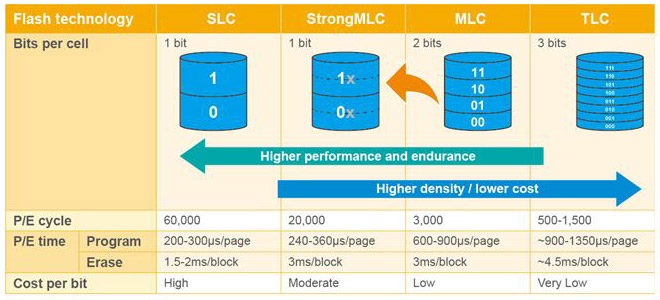Enhanced Endurance
MEMXPRO flash handling algorithms optimize the performance and lifespan of our Multi Level Cell (MLC) NAND Flash, providing customers with cost-effective, durable storage solutions. The firmware-based optimized design improves data integrity, accelerates flash performance, and extends the lifetime of an SSD. This ensures MEMXPRO’s StrongMLC and MLC Plus SSDs are enterprise-class deployments.
StrongMLC

The Comparison Chart of SLC/StongMLC/MLC/TLC
MEMXPRO provides StrongMLC solutions that enable high-quality MLC flash to perform in SLC mode for better performance, reliability and endurance over basic MLC flash memory - yet without the high price of an SLC. SLC flash use a single cell to store a single bit of data and they are rated at 60,000 program/erase (P/E) cycles. MLC flash is more complex with four digital states in a single cell. This makes it denser for a specified area and cheaper to produce, but they wear out faster. Empowered by MEMXPRO firmware technology, StrongMLC solutions position themselves between SLC and MLC to create endurance, performance and price balance for various applications in industrial and embedded markets. StrongMLC has higher P/E cycles of 20,000 and its read/write performance is comparable with those of SLC. The choice of technology is completely is determined by the nature of your project, its operating environment, and the balance between performance and cost considerations.
TRIM
SSD TRIM is an Advanced Technology Attachment (ATA) command that enables an operating system to inform a NAND flash SSD which data blocks it can erase because they are no longer in use. The use of TRIM can improve the Garbage Collection process, contributing to the performance of writing data to SSDs and longer SSD life. MEMXPRO SSD drives enables TRIM to make sure that SSD performance doesn’t degrade with use.
Wear Leveling
Wear Leveling is a process that helps reduce premature wear in NAND Flash storage devices. MEMXPRO SSD and flash drives incorporate both static and dynamic wear leveling for greater extended life of the SSD. Static wear leveling directs the blocks that are inactive and have data stored in them. Dynamic wear leveling provides a method for distributing program and erase cycle evenly on all of the blocks of an SSD, making sure all cells receive the same number of writes, to prevent writing too often on the same memory blocks.